Page 3 of 531
TABLE OF CONTENTSSECTIONPAGE
1INTRODUCTION.............................................................3
2THINGS TO KNOW BEFORE STARTING YOUR VEHICLE...............................9
3UNDERSTANDING THE FEATURES OF YOUR VEHICLE...............................97
4UNDERSTANDING YOUR INSTRUMENT PANEL................................... 219
5STARTING AND OPERATING................................................. 321
6WHAT TO DO IN EMERGENCIES...............................................409
7MAINTAINING YOUR VEHICLE............................................... 431
8MAINTENANCE SCHEDULES.................................................. 489
9IF YOU NEED CONSUMER ASSISTANCE..........................................497
10INDEX....................................................................507
1
2
3
4
5
6
7
8
9
10
Page 8 of 531
WARNINGS AND CAUTIONS
This manual containsWARNINGSagainst operating
procedures that could result in an accident or bodily
injury. It also containsCAUTIONSagainst procedures
that could result in damage to your vehicle. If you do not
read this entire manual you may miss important infor-
mation. Observe all Warnings and Cautions.
VEHICLE IDENTIFICATION NUMBER
The Vehicle Identification Number (VIN) is found on the
left front corner of the instrument panel, visible through
the windshield. This number also appears on the Auto-
mobile Information Disclosure Label affixed to a window
on your vehicle, the vehicle registration and title.
NOTE:It is illegal to remove the VIN.
Vehicle Identification Number
6 INTRODUCTION
Page 21 of 531

Arming The System
Remove the key from the ignition switch and either press
a power door lock switch while the driver or passenger
door is open or press the LOCK button on the Remote
Keyless Entry (RKE) transmitter. After all the doors are
locked and closed the Vehicle Security Alarm Indicator
Light in the instrument cluster will flash rapidly to signal
that the system is arming. The Vehicle Security Alarm
Indicator Light in the instrument panel cluster will flash
rapidly for about 16 seconds to indicate that the alarm is
being set. After the alarm is set, the Vehicle Security
Alarm Indicator Light, located in the lower center section
of the instrument cluster, will flash at a slower rate to
indicate that the system is armed.
NOTE:If the Vehicle Security Alarm Indicator Light
stays on continuously during vehicle operation, have the
system checked by your authorized dealer.
Disarm The System
Either press the UNLOCK button on the RKE transmitter
or insert a valid ignition key into the ignition switch and
turn the key to the ON position.
NOTE:
²The driver's door key cylinder and the liftgate button
on the RKE transmitter cannot arm or disarm the
system.
²The system remains armed during liftgate entry. Press-
ing the liftgate button will not disarm the system. If
someone enters the vehicle through the liftgate and
opens any door the alarm will sound.
²When the system is armed, the interior power door
lock switches will not unlock the doors.
The Vehicle Security Alarm system is designed to protect
your vehicle; however, you can create conditions where
the system will give you a false alarm. If one of the
THINGS TO KNOW BEFORE STARTING YOUR VEHICLE 19
2
Page 68 of 531
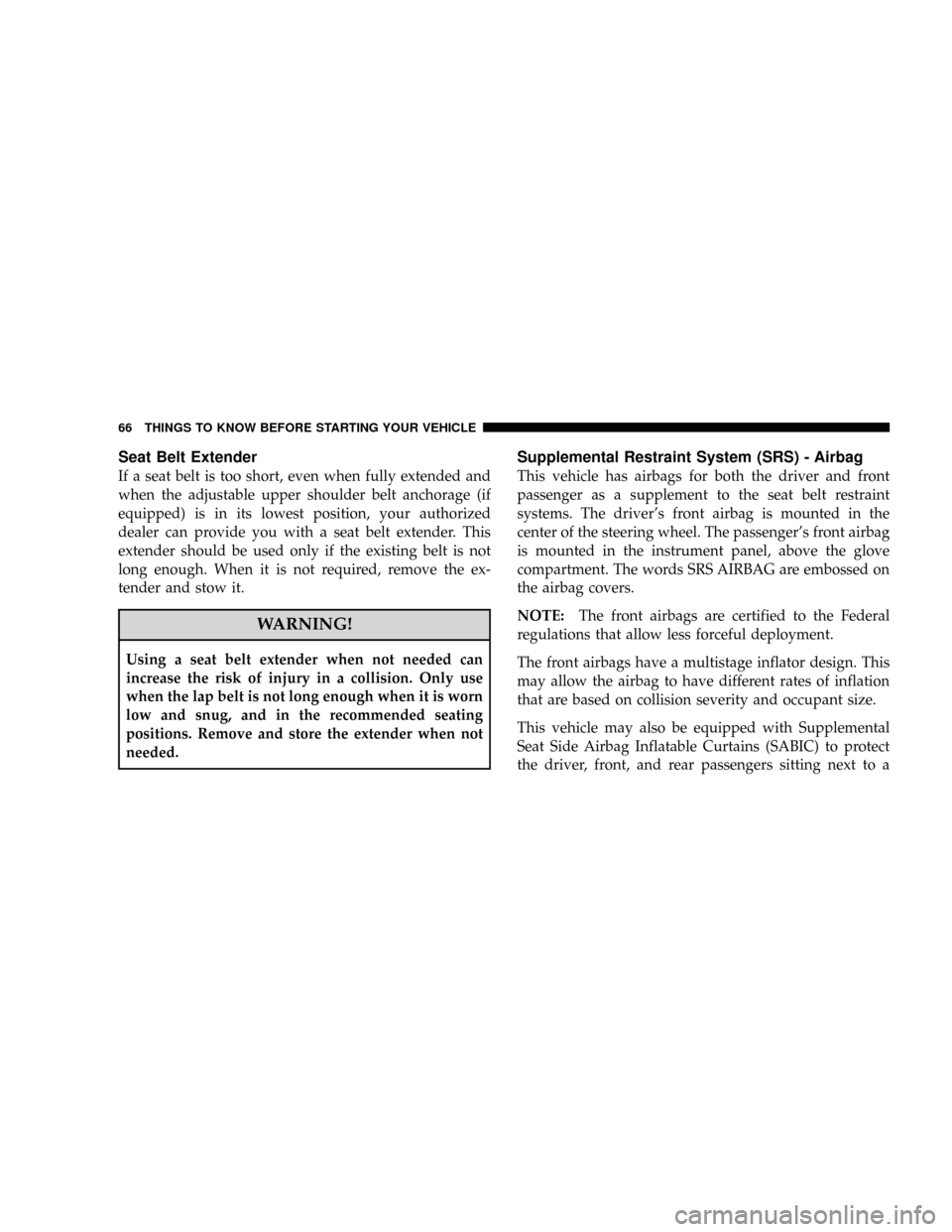
Seat Belt Extender
If a seat belt is too short, even when fully extended and
when the adjustable upper shoulder belt anchorage (if
equipped) is in its lowest position, your authorized
dealer can provide you with a seat belt extender. This
extender should be used only if the existing belt is not
long enough. When it is not required, remove the ex-
tender and stow it.
WARNING!
Using a seat belt extender when not needed can
increase the risk of injury in a collision. Only use
when the lap belt is not long enough when it is worn
low and snug, and in the recommended seating
positions. Remove and store the extender when not
needed.
Supplemental Restraint System (SRS) - Airbag
This vehicle has airbags for both the driver and front
passenger as a supplement to the seat belt restraint
systems. The driver's front airbag is mounted in the
center of the steering wheel. The passenger's front airbag
is mounted in the instrument panel, above the glove
compartment. The words SRS AIRBAG are embossed on
the airbag covers.
NOTE:The front airbags are certified to the Federal
regulations that allow less forceful deployment.
The front airbags have a multistage inflator design. This
may allow the airbag to have different rates of inflation
that are based on collision severity and occupant size.
This vehicle may also be equipped with Supplemental
Seat Side Airbag Inflatable Curtains (SABIC) to protect
the driver, front, and rear passengers sitting next to a
66 THINGS TO KNOW BEFORE STARTING YOUR VEHICLE
Page 69 of 531
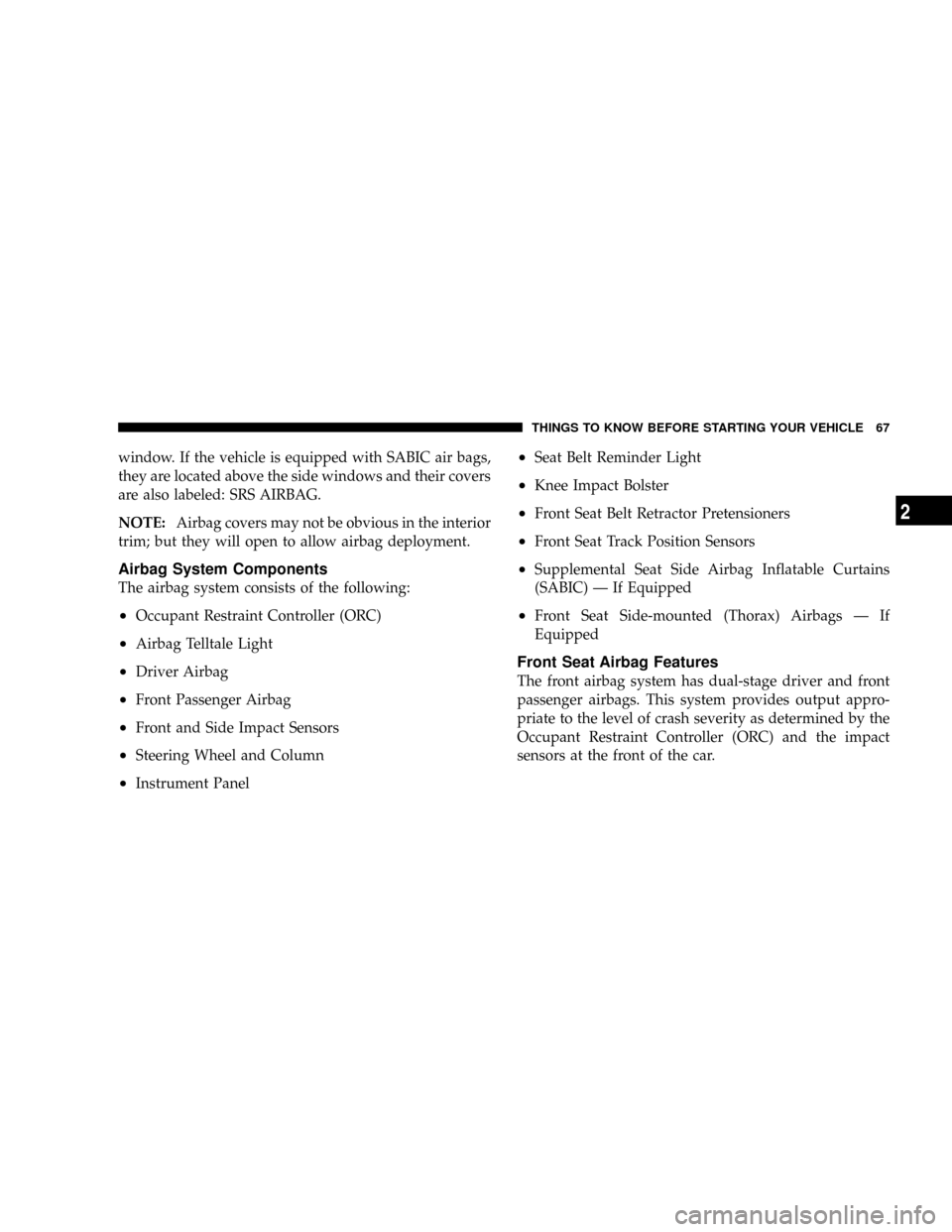
window. If the vehicle is equipped with SABIC air bags,
they are located above the side windows and their covers
are also labeled: SRS AIRBAG.
NOTE:Airbag covers may not be obvious in the interior
trim; but they will open to allow airbag deployment.
Airbag System Components
The airbag system consists of the following:
²Occupant Restraint Controller (ORC)
²Airbag Telltale Light
²Driver Airbag
²Front Passenger Airbag
²Front and Side Impact Sensors
²Steering Wheel and Column
²Instrument Panel
²Seat Belt Reminder Light
²Knee Impact Bolster
²Front Seat Belt Retractor Pretensioners
²Front Seat Track Position Sensors
²Supplemental Seat Side Airbag Inflatable Curtains
(SABIC) Ð If Equipped
²Front Seat Side-mounted (Thorax) Airbags Ð If
Equipped
Front Seat Airbag Features
The front airbag system has dual-stage driver and front
passenger airbags. This system provides output appro-
priate to the level of crash severity as determined by the
Occupant Restraint Controller (ORC) and the impact
sensors at the front of the car.
THINGS TO KNOW BEFORE STARTING YOUR VEHICLE 67
2
Page 74 of 531
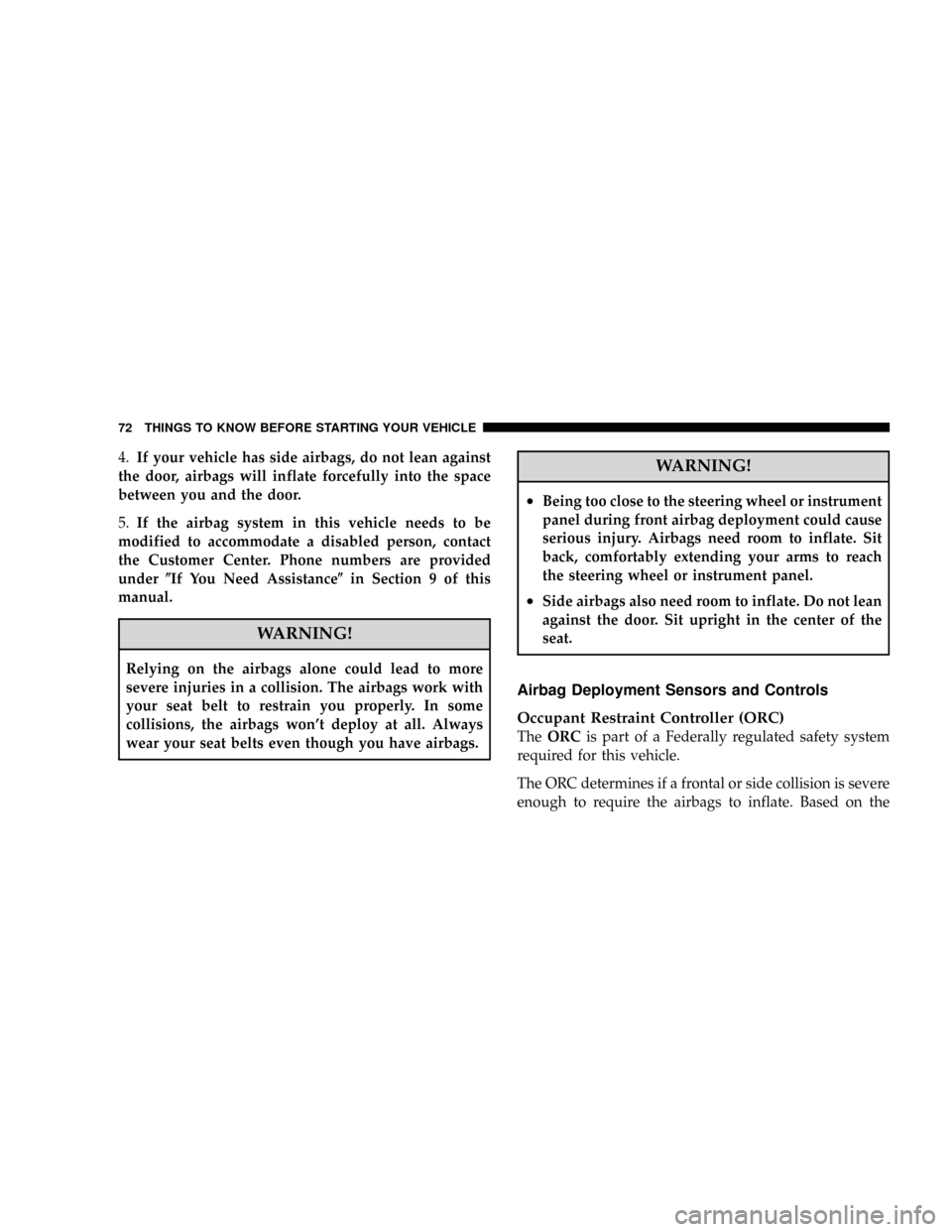
4.If your vehicle has side airbags, do not lean against
the door, airbags will inflate forcefully into the space
between you and the door.
5.If the airbag system in this vehicle needs to be
modified to accommodate a disabled person, contact
the Customer Center. Phone numbers are provided
under(If You Need Assistance(in Section 9 of this
manual.
WARNING!
Relying on the airbags alone could lead to more
severe injuries in a collision. The airbags work with
your seat belt to restrain you properly. In some
collisions, the airbags won't deploy at all. Always
wear your seat belts even though you have airbags.
WARNING!
²Being too close to the steering wheel or instrument
panel during front airbag deployment could cause
serious injury. Airbags need room to inflate. Sit
back, comfortably extending your arms to reach
the steering wheel or instrument panel.
²Side airbags also need room to inflate. Do not lean
against the door. Sit upright in the center of the
seat.
Airbag Deployment Sensors and Controls
Occupant Restraint Controller (ORC)
TheORCis part of a Federally regulated safety system
required for this vehicle.
The ORC determines if a frontal or side collision is severe
enough to require the airbags to inflate. Based on the
72 THINGS TO KNOW BEFORE STARTING YOUR VEHICLE
Page 75 of 531
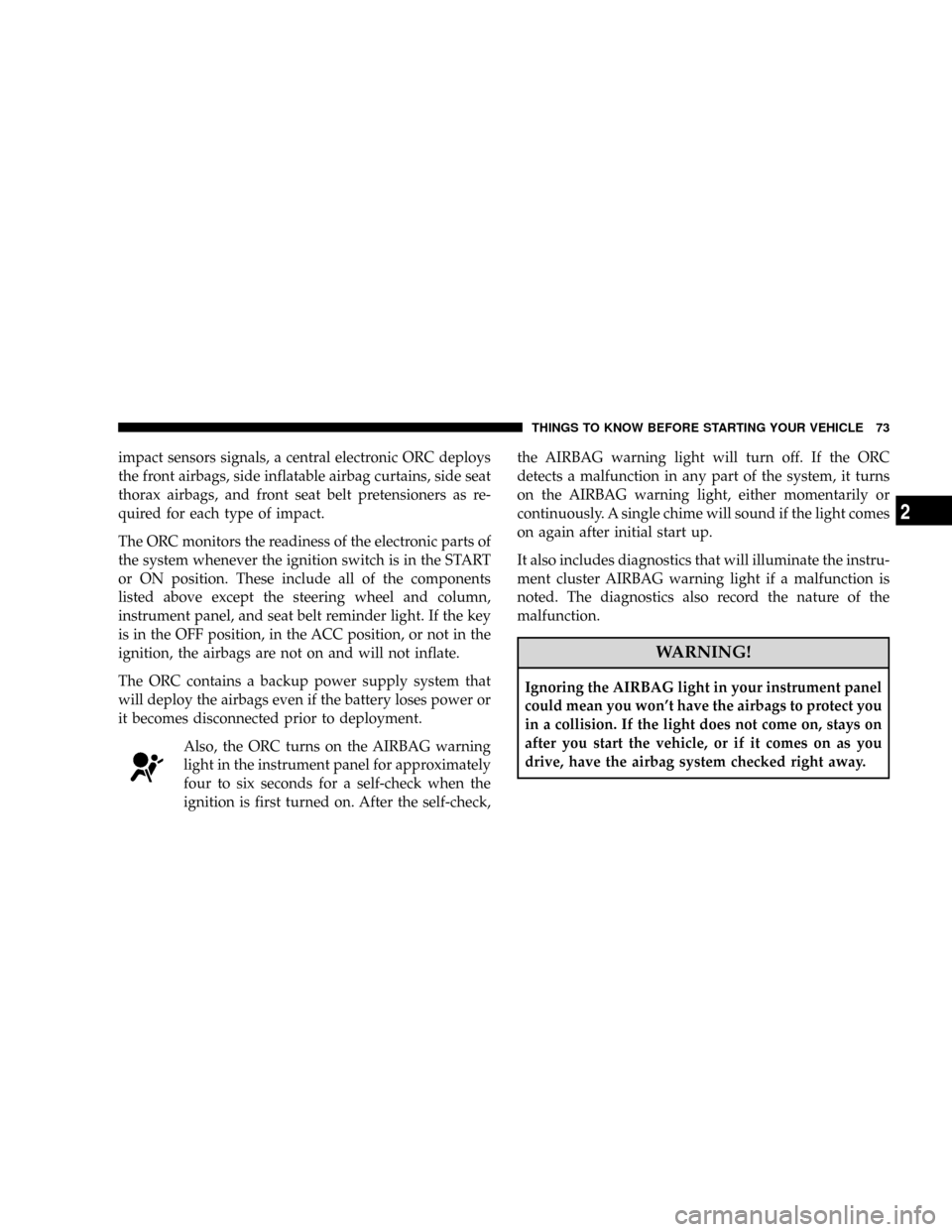
impact sensors signals, a central electronic ORC deploys
the front airbags, side inflatable airbag curtains, side seat
thorax airbags, and front seat belt pretensioners as re-
quired for each type of impact.
The ORC monitors the readiness of the electronic parts of
the system whenever the ignition switch is in the START
or ON position. These include all of the components
listed above except the steering wheel and column,
instrument panel, and seat belt reminder light. If the key
is in the OFF position, in the ACC position, or not in the
ignition, the airbags are not on and will not inflate.
The ORC contains a backup power supply system that
will deploy the airbags even if the battery loses power or
it becomes disconnected prior to deployment.
Also, the ORC turns on the AIRBAG warning
light in the instrument panel for approximately
four to six seconds for a self-check when the
ignition is first turned on. After the self-check,the AIRBAG warning light will turn off. If the ORC
detects a malfunction in any part of the system, it turns
on the AIRBAG warning light, either momentarily or
continuously. A single chime will sound if the light comes
on again after initial start up.
It also includes diagnostics that will illuminate the instru-
ment cluster AIRBAG warning light if a malfunction is
noted. The diagnostics also record the nature of the
malfunction.
WARNING!
Ignoring the AIRBAG light in your instrument panel
could mean you won't have the airbags to protect you
in a collision. If the light does not come on, stays on
after you start the vehicle, or if it comes on as you
drive, have the airbag system checked right away.
THINGS TO KNOW BEFORE STARTING YOUR VEHICLE 73
2
Page 78 of 531
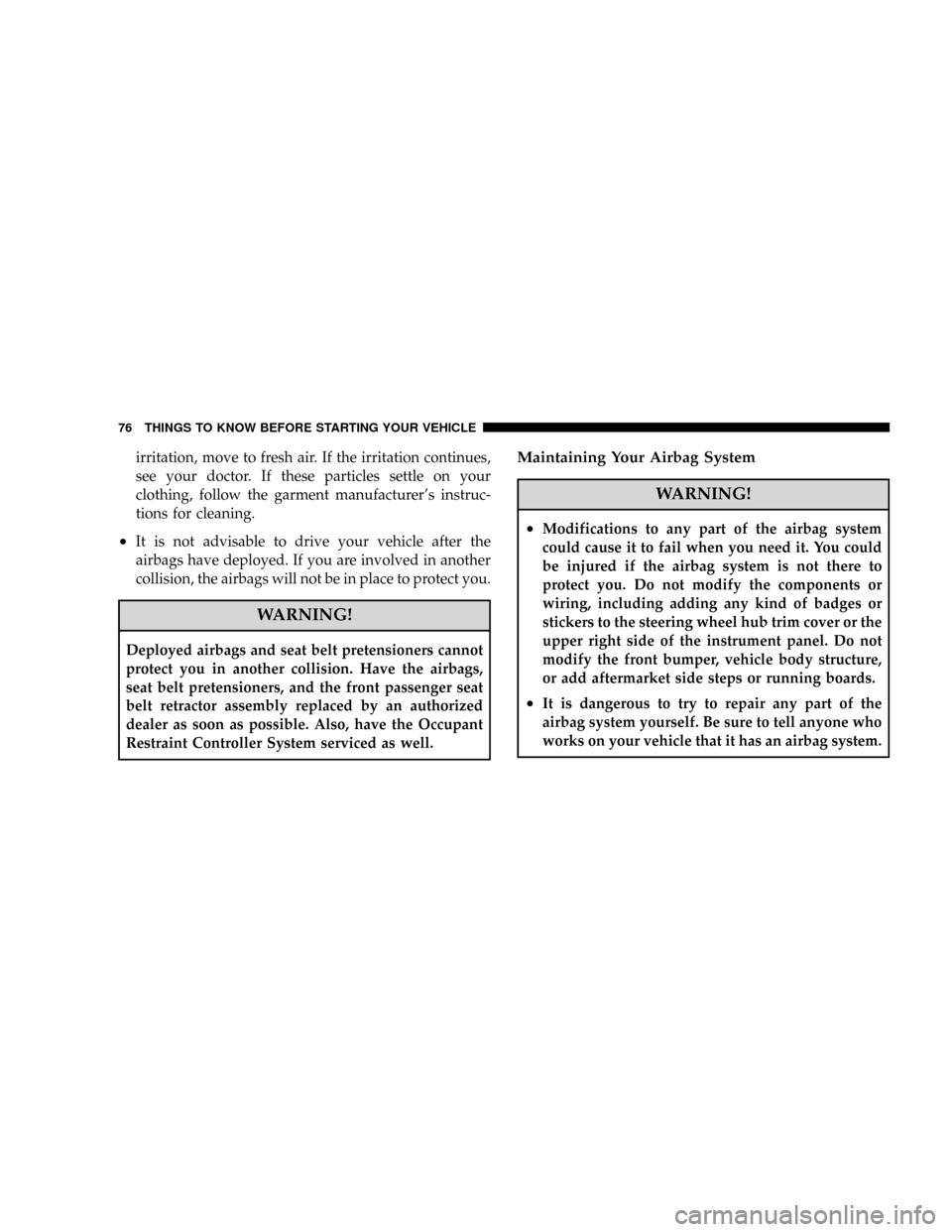
irritation, move to fresh air. If the irritation continues,
see your doctor. If these particles settle on your
clothing, follow the garment manufacturer's instruc-
tions for cleaning.
²It is not advisable to drive your vehicle after the
airbags have deployed. If you are involved in another
collision, the airbags will not be in place to protect you.
WARNING!
Deployed airbags and seat belt pretensioners cannot
protect you in another collision. Have the airbags,
seat belt pretensioners, and the front passenger seat
belt retractor assembly replaced by an authorized
dealer as soon as possible. Also, have the Occupant
Restraint Controller System serviced as well.
Maintaining Your Airbag System
WARNING!
²Modifications to any part of the airbag system
could cause it to fail when you need it. You could
be injured if the airbag system is not there to
protect you. Do not modify the components or
wiring, including adding any kind of badges or
stickers to the steering wheel hub trim cover or the
upper right side of the instrument panel. Do not
modify the front bumper, vehicle body structure,
or add aftermarket side steps or running boards.
²It is dangerous to try to repair any part of the
airbag system yourself. Be sure to tell anyone who
works on your vehicle that it has an airbag system.
76 THINGS TO KNOW BEFORE STARTING YOUR VEHICLE